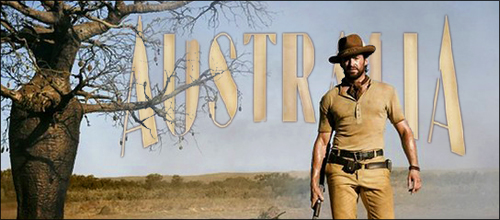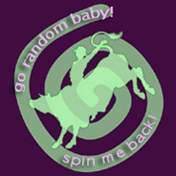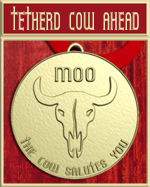Sun 30 Nov 2008
Australia
Posted by anaglyph under Australiana, Movies
[20] Comments

Yeah, I know, I tell you I don’t do movie reviews and yet here’s another one of the damn things. What can I say – I feel compelled to comment on this one for the benefit of my buddies who worked on it and all my overseas readers who may or may not care to see it. So sue me – I’m making this blogging thing up as I go along.
First of all, I’ll get this out of the way so those of you looking for my usual acerbic cynicism can go read The Onion – I liked Baz Luhrmann’s Australia and I’m going to say mostly nice things about it. It’s a big, corny, campy mash of Gone With the Wind, Once Upon a Time in the West, Out of Africa and The Wizard of Oz that makes no excuse for being a melodrama of epic proportions. In fact, it is aligned so much in temperament with Luhrmann’s three ‘Red Curtain’ movies (Strictly Ballroom, Romeo + Juliet, and Moulin Rouge) that I’m not sure why he has publicly divorced it from those films – it seems to me that preparing an audience to approach it as part of that ouvre might actually help them understand where it’s coming from.
There’s really not a lot to the plot of Australia. It’s a simple tale in two acts that weaves together a three-way love story, cultural biases & preconceptions, and big set action pieces, into a saga of grand, technicolour brushtrokes. It’s not David Lean, and it’s not Sergio Leone (even if it nods at both those directors) but it truly is Baz Luhrmann.
It is, in my opinion, a good thing that Russell Crowe, who was originally cast in the part of ‘The Drover’, pulled out of the film. There would be few who would disagree that, in this picture, Hugh Jackman really owns the role of the stereotypical laconic bushman, and as much as I really didn’t quite buy into the supposed passion between Jackman and Nicole Kidman (playing the prissy-but-ultimately-feisty Lady Sarah Ashley), I think I’d have bought it far less with Crowe doing the canoodling. The cast does a pretty credible job in the main, with Brandon Walters as ‘Nullah’ upstaging just about everyone without apparently even trying, and Bryan Brown and David Wenham playing bad guys of such extreme pantomime that I expected that they just might attempt to tie Kidman to some railway tracks.
For Australians, the film is a real round-up of familiar local performing talent. Barry Otto, Bruce Spence, Jack Thompson, David Gulpilil, Arthur Dignam, John Jarratt, Max Cullen, Sandy Gore and a host of other recognizable faces flit across the screen, filling the movie with a nostalgia that few foreigners will feel. The Australian countryside never looked more spectacular, lush with beauty from billabong to Never Never. With all these elements in play it’s as if Luhrmann has tried to distill the essence of every Australian ‘landscape’ film ever made (and by that I mean the films of grand throw, such as Sunday Too Far Away; The Chant of Jimmie Blacksmith; Mad Max; Priscilla, Queen of the Desert; Dead Heart; The Man From Snowy River; Rabbit Proof Fence et al) into one swirling mélange of Aussie popular film history. The music by David Hirschfelder operates on a similar level of pastiche, deftly weaving together quotes and variations on Sheep May Safely Graze, Somewhere Over the Rainbow and Waltzing Matilda with the original score. Other references to Australian culture abound; Nullah’s dog is called Jedda; Lady Ashley’s horse is called Capricornia. It’s this cheeky love of detail, and the film’s sense of fun with the high drama that confidently keeps it from veering towards what could easily have been a rudderless mess. It’s truly operatic cinema.
The film is beautifully photographed by Mandy Walker and the costumes by Catherine Martin are gritty or pretty, as required. The production design and art direction are rich and elaborate – unsurprising in a Luhrmann picture, and the film sounds good and solid, if a little workmanlike (personal beef: if you’re making all your other components so hyperbolic, why wimp out on the sound?). There is rather too much music for my taste, and some of the visual effects are a bit ropey, but that’s hardly surprising given the rush in post-production to meet the screening date. The pic has been criticized for being over-long, and long it is, but it is always engaging enough to stop it bogging down.
Is Australia a true reflection of Australia?
Yes. Outback cattle stations do really look like that, and those big droves really did happen; Australians do really talk like that,† (although a drover would likely use something a little more salty than ‘Crikey!’ as an expletive); there really was a man known as ‘The Cattle King’ (Sir Sidney Kidman – no relation as far as I know) who systematically bought up millions of acres of outback cattle country and became very wealthy; the Aboriginal people really do ‘sing’ the land; Darwin really was bombed in WWII (the only serious incursion of the Japanese into Australian territory‡); we do shoot kangaroos, and eat them; Aboriginal trackers did help the white police hunt Aboriginal ‘fugitives’, and Aboriginal children were, for far too many years, removed from their families and raised in ‘good Christian missions’ (including an island off the coast of the Northern Territory); the Wet does save the land every year, and the results are just as spectacular as they look in the movie.
The flavour of an archetypical and mythical Australia suffuses the film, and I’m really glad about that, even if it is mostly a cliché. It’s the same kind of myth that you find in the Wild West and the Deep South of the old-fashioned American cinema that I loved as a kid. No-one’s really attempted this in Australian cinema (with the exception of The Man From Snowy River, perhaps) and even if it’s kinda quaint as a concept, someone needed to do it, and that someone could really only have been Baz Luhrmann.
Is Australia a true reflection of Australia?
No. I can’t imagine a pub full of drinkers of any era actually singing rousing choruses of Waltzing Matilda; the real Cattle King, although famously tight-fisted, was not the villain he is painted in the film, and he died in 1935, well before the war started; as far as I know, there are not, and never have been, such tipples as ‘Poor Fella’ rum, or ‘Kanga’ lager; station bosses in the outback probably didn’t have revolvers in holsters as a general rule (I don’t say that with any authority – it’s just that rifles are much more useful than pistols out on the cattle stations); even though the Wet refreshes the land like nothing you’d believe, an outback station would hardly support an explosion of azaleas, a lawn, and – what was that – a frangipani? So Baz has been flexible with the truth in the interests of the operatic vision.
But then, the clinical Old West of Leone and Ford, the genteel South of Mitchell & Fleming and the frosty Russia of Lean are all colourful caricatures too, and we love them despite their foibles. Why not Australia?
I saw the film in a packed cinema here in Hollywood. I assume that the LA audience is relatively sophisticated and probably nearly as cynical as I am. Yet when the lights came up, they applauded the film and they applauded the director. They may not have left the cinema with an accurate historical picture of Australia but my guess is that they left with an accurate assessment of the spirit of Australia. And what more could you ask of a movie than that?
___________________________________________________________________________
†And not at ALL like the execrable supposedly-Australian accent I heard from an actor in Frost/Nixon the other night – you’d think they could find at least one Aussie actor in Hollywood…
‡Japanese ‘mini’ submarines also made it into Sydney Harbour, quite unbelievably, but caused little damage.
___________________________________________________________________________
20 Responses to “ Australia ”
Trackbacks & Pingbacks:
-
[…] my vision, rugged-but-handsome-stockmen would roam the precinct offering parched visitors a cold one, and sundrenched maidens would hand […]




Au contraire, mon pere. Kanga Brew is made by the Australian Beer Company and is described as a pale lager!
But what I really want to know is what does kangaroo taste like? Chicken, perhaps?
Catalyst: Well, I stand corrected, but I think that Kanga Brew is a rather later addition to the Australian beer pantheon than the one depicted in the film, which I think was called Kanga Lager, or Kanga Bitter. I suspect that the production company actually made up those products in line with the film’s ‘semi-real’ mythology (And I don’t think I’ve ever seen Kanga Brew on sale actually in Australia… it’s probably one of those things that does rather better in export. Like Fosters).
Kangaroo tastes quite good – like lean beef, sort of, slightly gamey, very good meat. Particularly good on the barbecue.
Perhaps I will see this, after all. The trailer did absolutely nothing for me whatsoever, and Nicole Kidman is about as atrocious an actress as they come. Give me Naomi Watts or Miranda Otto any day.
If you like Gone With the Wind, or Once Upon a Time in the West, go see it. If you don’t, don’t.
Thanks Rev, you’ve changed my mind, I’ll give it a go.
…and I agree, kangaroo is a fantastic meat to barbeque. BBQ medium rare, and then rest for 10 mins before slicing into a summer salad with baby beetroot, rocket and chickpeas.
Off now to look through my borrowed telescope at Venus, Jupiter and the Moon.
Well Rev, you surprise me (guess that’s why I visit every so often) but I suspect – in fact I know that I won’t be joining the Queen to see this one.
Strictly Ballroom I could handle, the other two – yurk, guess it’s just me. But sopfests ain’t my ting – I felt like the patient englishman sitting through The English Patient, Truly Madly Deeply was Truly Truly Awful, and the list goes on of films Pil loved and I hated (or laughed in the ‘wrong’ spots at).
I’ll have a nice quiet night in watching Battlestar or Deadwood perhaps, or maybe even High Plains Drifter or The Good, The Bad and The Ugly.
As previously mentioned Kangaroo is delicious, very lean, free-range, and cheaper than beef – though it appears at many of the best restaurants, Pil and I consume great quantities of it at times.
We do have some rather odd beers here, a relative newcomer is:
http://www.bluebottlebeer.com.au/
A Bluebottle is a rather nasty small stinging jellyfish, so I guess the marketing boys were taking a line like Michael Jackson calling his album “Bad”. Or perhaps the taste is a tad astringent..?
Perhaps a little like Baz”s films are for me.
The King
Pil: It’s fun – you should see it.
King Willy: I doubt you’d enjoy it, although I do wonder. Baz is definitely a showman, and he doesn’t approach things too seriously. But if you didn’t like his last two films you definitely won’t like this. Personally, I think his Romeo + Juliet is one of the strongest and most powerful films ever made by an Australian, and one of the very finest attempts to bring Shakespeare to the screen.
You know, I’ve seen this twice now and I have to say that going late after stuffing yourself full of different sizes and shapes of heavy holiday food is a bad idea. Watching a later after I had a little more energy and was able to sit still a little better, the movie improved ten fold.
My one problem with the movie stands, though. Not a problem with the movie exactly, a problem with the business around it. The previews made it look like a war movie with just enough lovey-dovey crap to keep the girls interested. It was, instead, a three hour long love fest. Which is fine, but I would probably not have went late at night if I knew there would be so few explosions.
I did love it once I had it on its own terms, I guess. I also recommend not taking teenage nieces as dates. Even though my 40 something friend I took with me pretty much tittered and squealed more or less the same way as the other two during any Hugh Jackman related man-minutes.
Casey: The second trailer that was released here in the US was misleading – largely because of its spectacular ending. Sometimes I really don’t know what the marketing people from the studios are thinking (if they are even thinking at all) – they may swindle people briefly with deceptive advertising, but they should really know by now that audiences are not idiots and will resent being tricked into seeing a film they really didn’t want to see.
Several commentators are calling the style of the marketing a bad play, and that kind of thing is at least as important in the success or failure of a film as the film itself. When so much hangs on the first few days of Box Office people lose their heads if they start to get nervous about what it is they’re selling
Which only serves to make Bazmark’s motto ‘A Life Lived in Fear is a Life Half Lived’ all the more pertinent.
And Jackman is Damn sexy!
Even I’ll admit he’s a good lookin’ man.
Here’s another pic for the girls:
http://membres.lycos.fr/ariochld/Images/HighPlainsDrifter.jpg
The King
Oh, Mr Luhrmann is completely aware of that particular parallel, believe me.
Cool review. The music must’ve been good enough if a pro like you was ok with it.
Jackman’s all right, but he ain’t Eastwood, though he resembles him. Clint in his heyday was a mean muther and at his best when he snarls, so wouldn’t have been a good fit for an epic any more than Jackman would have fit a spaghetti western.
I appreciate the Epic qualities you espouse on this film, though I’m more a Mad Max guy. The wife will probably enjoy seeing it, and I’m never one to shy away from Nicole Kidman.
One thing I forgot to mention was that the music was very good. Normally I’m not one for over the top scores, but the little hints of Waltzing Matilda and other familiar tunes worked really well with the over the top nature of the whole production. Personally, my favorite soundtrack/music was from the show Monster’s Ball, so I obviously like the minimalist ambient noise style.
But this one was good. Showy and grand, but only in keeping with the movie. You are right about the sound, though. I would have liked more of the 2X4 hitting a table sound when punches flew.
I am mildly tempted to see the film (Pil … need a date?) but I don’t know if I could look at that shiny plastic immobile face for three hours. Your review is a public service – Helping The Discerning Make Movie Selection.
Mate, it had more cheese than a margherita pizza, but I liked it!
I didn’t really go in with any expectations but I actually found it to be a decent bit of escapism. Sure it was corny, but it was fun. And there ain’t nuthin’ wrong with that. The only thing that really bugged me was that swooping zoom over the landscape close to the start of the film. Nearly made me barf.
I had a dream about this website last night. Weird. *still in a daze*
Lexie: Ah. That would be the beta tests of the new Tetherd Cow Ahead ‘Dream Broadcast’™ technology.
Oh Australia, so much like the wild west.